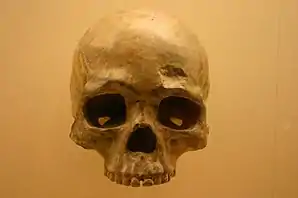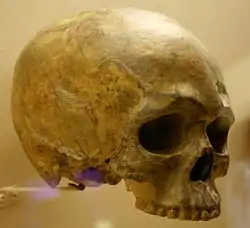Liujiang man
The Liujiang men (Chinese: 柳江人) are among the earliest modern humans (Homo sapiens) found in East Asia. Their remains were discovered in the Tongtianyan Cave (通天岩) in Liujiang, Guangxi, China.[1]

The remains were excavated in 1958. The remains consist of a well-preserved adult cranium, a right innominate (hip bone), complete sacrum, multiple vertebrae, and two femoral fragments. All remains are believed to belong to one individual.[2]
Very little is known about the specimen due to a lack of academic sources published within the United States. There seems to be a discrepancy in determining accurate dates of the specimen due to the unknown stratigraphic context in which the remains were found.[3]
The remains are dated to the Late Pleistocene, most likely to about 67,000 years ago. High rates of variability yielded by various dating techniques carried out by different researchers place the most widely accepted range of dates with 67,000 BP as a minimum, but does not rule out dates as old as 159,000 BP.[2] Any date prior to 50,000 years ago is surprising, as it would seem to predate the "recent dispersal" scenario of coastal migration ("Out of Africa II"). The remains have been considered in the context of a possible early dispersal which left Africa before 100,000 years ago, but which was extinct (or "retracted back to Africa") before the arrival of the "recent dispersal" wave.[4]
Morphology

Regional population variation in sexual dimorphism hypothesis
Most scholars have interpreted the cranium of the specimen as male, but have encountered difficulties reaching a consensus in the sex of the pelvis. Scholar Karen Rosenburg argues that this difficulty is indicative of regional variation in the degree of sexual dimorphism consistent with modern populations.[2] The degree of morphology variation consistent with modern populations suggest that the fossils may not be as old as previously thought.[3]
Cranium (1567 cc)
The cranium of the Liujiang specimen is one of the most complete to be found in China. The cranium was found filled with a stone matrix. The matrix filling the brain was scanned using computed tomography (CT) and turned into a reconstructed 3D image of the brain. The shape of the brain shares many similarities with modern humans including a rounded shape, wide frontal lobes, and enlarged brain height. One major difference between the Liujiang specimen and modern Chinese populations was the enlarged occipital lobes found on the Liujiang specimen. The common features between the Liujiang specimen and modern humans along with the cranial capacity of the skull (1567 cc) places the specimen within the range of modern humans.[5]
References
- Shen, G.; Wang, W.; Wang, Q.; Zhao, J.; Collerson, K.; Zhou, C.; Tobias, P. V. (2002). "U-Series dating of Liujiang hominid site in Guangxi, Southern China". Journal of Human Evolution. 43 (6): 817–829. doi:10.1006/jhev.2002.0601. PMID 12473485.
- Rosenburg, Karen (2002). "A Late Pleistocene Human Skeleton from Liujiang, China Suggests Regional Population Variation in Sexual Dimorphism in the Human Pelvis". Variability and Evolution.
- Kaifu, Yousuke (2012). "Fossil Record of Early Modern Humans in East Asia". Palaeoenvironmental Changes and Human Dispersals in North and East Asia during MIS3 and MIS2.
- Liu, Hua; Prugnolle, Franck; Manica, Andrea; Balloux, François (August 2006). "A geographically explicit genetic model of worldwide human-settlement history". American Journal of Human Genetics. 79 (2): 230–7. doi:10.1086/505436. PMC 1559480. PMID 16826514.
- Wu, XiuJie (2008). "The Brain Morphology of Homo Liujiang Cranium Fossil by Three-dimensional Computed Tomography". Chinese Science Bulletin.